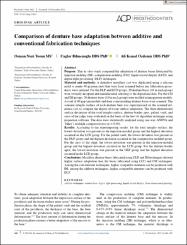Comparison of denture base adaptation between additive and conventional fabrication techniques
Özet
Purpose: This in vitro study compared the adaptation of denture bases fabricated by
injection molding (IM), compression molding (CM), liquid crystal display (LCD), and
digital light processing (DLP) techniques.
Material and methods: A definitive maxillary cast was duplicated using a silicone
mold to create 40 gypsum casts that were laser scanned before any fabrication procedures were initiated. For the DLP and LCD groups, 20 denture bases (10 in each group)
were virtually designed and manufactured referring to the digitalized data. For the CM
and IM groups, 20 denture bases (10 in each group) were molded using gypsum models.
A total of 40 gypsum models and their corresponding denture bases were scanned. The
scanned intaglio surface of each denture base was superimposed on the scanned reference cast to compare the degree of tissue surface adaptation. The three-dimensional
surface deviations of the total intaglio surface, denture border apex, palatal vault, and
crest of the ridge were evaluated on the basis of the best fit algorithm technique using
inspection software. The data were statistically analyzed using one-way ANOVA and
Tukey’s multiple comparison test (α = 0.05).
Results: According to the superimposing results, for the total intaglio surface, the
lowest deviation was present on the injection-molded group and the highest deviation
occurred on the LCD group. For the palatal vault, the lowest deviation was present on
the DLP group and the highest deviation occurred in the compression molded group.
For the crest of the ridge, the lowest deviation was present in the injection-molded
group and the highest deviation occurred in the LCD group. For the denture border
apex, the lowest deviation was present in the DLP group and the highest deviation
occurred in the LCD group.
Conclusions: Maxillary denture bases fabricated using DLP and IM techniques showed
higher surface adaptation than the bases fabricated using LCD and CM techniques.
Among the conventional techniques, higher compatible dentures can be produced with
IM; among the additive techniques, higher compatible dentures can be produced with
DLP.
Bağlantı
https://hdl.handle.net/11363/4378Koleksiyonlar
Aşağıdaki lisans dosyası bu öğe ile ilişkilidir:


















